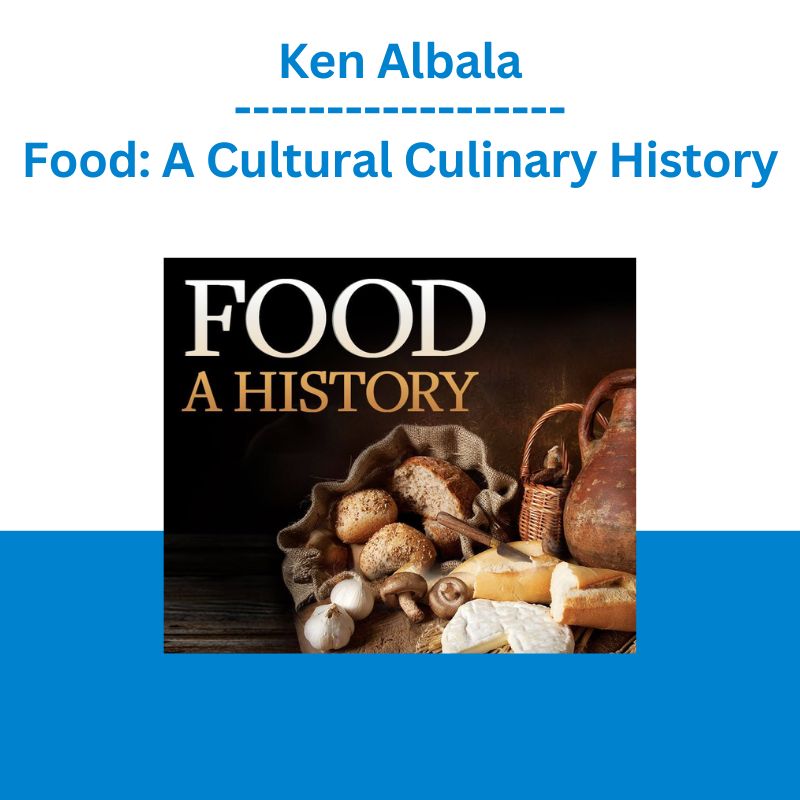*** Proof of Product ***
Exploring the Essential Features of “Ken Albala – Food: A Cultural Culinary History”
Food: A Cultural Culinary History
Learn how the entirety of human civilization-war, trade, politics, art, religion, and more-has been shaped by our interaction with food in this delicious course.
LECTURE (36)
01:Hunting, Gathering, and Stone Age Cooking
Consider food as a major catalyst in human history, and what food choices reveal about our values and ambitions. Then study food culture in prehistoric times-our ancestors’ wide-ranging diet of everything from mammoths and seafood to acorns, insects, seeds, and grasses-and the ways in which how they ate directly drove evolution. …
02:What Early Agriculturalists Ate
The transition to agriculture was perhaps humanity’s single greatest social revolution, with mixed results. Explore the factors surrounding the rise of agriculture, how plants and animals were domesticated, and why agriculture directly led to civilization as we know it. Learn how the menu of foods favored by agricultural societies came about….
03:Egypt and the Gift of the Nile
Ancient Egypt’s prosperity, court culture, and isolation from conflict led to a sophisticated food tradition and the first “elite” cuisine. Study the archaeological evidence of their food customs, the religious significance of foodstuffs and animals, and the components of their cuisine, encompassing grains, wine, bread, numerous vegetables, and wild game….
04:Ancient Judea-From Eden to Kosher Laws
Practices regarding food were deeply integral to the lives of the ancient Hebrews. Explore prescriptions regarding food in Genesis, and consider that the Fall itself was an act of eating. Then learn about the Hebrew rituals and meaning of sacrifice, and note the Hebrews’ complex food prohibitions, rooted in what was considered clean and unclean….
05:Classical Greece-Wine, Olive Oil, and Trade
Grasp how the ancient Greeks’ need for arable land led to their imperial and mercantile system, and consider what we learn about their food culture from Homer, Hesiod, Pythagoras, and Plato. Observe the role of food in the rituals of festivals, religious cults, and symposia, and study simple components of the classical Greek diet that later influenced the rest of the world. …
06:The Alexandrian Exchange and the Four Humors
Alexander’s conquests heralded an era where previously unconnected cultures mixed on a large scale. Trace the diffusion of foodstuffs over vast trade networks in the Hellenistic period. Study early dietary regimens based in Galen’s famous theory of the body’s “humors,” and the influence on food culture of philosophical schools such as the Stoics and Epicureans….
07:Ancient India-Sacred Cows and Ayurveda
Ancient India gave birth to culinary traditions that still carry wide influence. Learn about the culture of the Aryans, whose religion prefigured Hinduism; food customs relating to caste; and the traditions of vegetarianism in Hinduism, Jainism, and Buddhism. Also study the dietetic system of Ayurvedic medicine and the components of Indian cuisine. …
08:Yin and Yang of Classical Chinese Cuisine
Chinese culture produced what is arguably the most complex, sophisticated, and varied culinary tradition on earth. Trace the rise of civilization in China from the Hsia to the Han dynasty, the social and technological factors underlying China’s elaborate food traditions, and the role of Taoist thought and Chinese medicine in diet….
09:Dining in Republican and Imperial Rome
Here, delve into intriguing contrasts in the dining habits of the ancient Romans. From the simple food customs of republican Rome, follow the expanding empire and how exotic food became a status symbol. Examine a cookbook aimed at those eager to flaunt their wealth, see how the satirist Juvenal responded, and witness the bizarre gastronomic decadence of the late empire….
10:Early Christianity-Food Rituals and Asceticism
Food and its symbolism played a distinct role in the development of Christianity. Observe the role of food in Jesus’s parables and miracles, as well as in the ritual of the Eucharist. Learn about early Christian and monastic dietary prescriptions, practices regarding ritual fasting, and the significance of purification through self-denial. …
11:Europe’s Dark Ages and Charlemagne
The fall of Rome and the rise of Germanic tribal kingdoms brought marked culinary changes to Europe. Study the “barbarian” diet and the culture of “fast and feast” rooted in the opposing ideals of Christian asceticism, meat-eating virility, and classical moderation. Trace Charlemagne’s dynamic rule and his impact on food culture….
12:Islam-A Thousand and One Nights of Cooking
The rise of Islam brought a new way of thinking about food. Contemplate the Muslim cultural values that permitted pleasure, the cultivation of the senses, and the creation of an exquisite cuisine. Study Islamic eating rituals and Persian-influenced culinary techniques, such as perfuming food and cooking meat with sweets….
13:Carnival in the High Middle Ages
In the wake of the Crusades, learn about the great innovations in medieval cooking spurred by contact with Islamic civilization, based in the sophisticated use of exotic spices and herbs. Trace the food rituals and exuberant indulgence of Carnival, and grasp the symbolism of outlandish folktales relating to food….
14:International Gothic Cuisine
Ironically, the plague in 14th-century Europe produced societal shifts that led to a resplendent era in food. Assess the influence of three seminal cookbooks and the craze for spices and sugar in the flourishing of “Gothic” cuisine. Study specific recipes, cooking techniques, and the culture of medieval court banquets….
15:A Renaissance in the Kitchen
The Italian Renaissance brought a new aesthetic approach to cookery, featuring great complexity of presentation. Uncover some of the era’s extremes in books by food writers Platina, Ficino, and Messisbugo, and note connections with the self-conscious sophistication of Mannerist painting. Study menus and recipes from the staggeringly elaborate banquets of the court of Ferrara….
16:Aztecs and the Roots of Mexican Cooking
Contemporary with the European Renaissance, Aztec culture produced a unique food tradition that survives today in Mexican cuisine. Learn first about Aztec society, its indigenous foodstuffs, and distinctive diet. Also study descriptions of lavish Aztec banquets; “signature” foods, from avocados, beans, and chilies to chocolate and maize; and the Aztec philosophy of balance and moderation in …
17:1492-Globalization and Fusion Cuisines
Humanity’s desire for spices and other luxury items eventually connected the entire globe. Track the powerful trading empires of the Venetians and Portuguese, the Spanish conquest of the New World, and the “Columbian exchange”-where plants and animals from five continents were globally transplanted, changing eating habits around the world….
18:16th-Century Manners and Reformation Diets
Across Europe in the 1500s, witness new dynamics in culture that brought the use of cutlery, elaborate tableware, ritualized behavior at table, and food ideologies distinct from courtly fashions. Also observe the effects of the religious Reformations on eating habits, seen in new dietary freedoms, fasting practices, and moralistic thinking about food. …
19:Papal Rome and the Spanish Golden Age
Here, explore the rise of distinct regional and national cuisines, focusing on Italy and Spain. Review the monumental culinary writings of Bartolomeo Scappi, bringing together specialty dishes from all of Italy. Then study excerpts from two classic books of Spanish cookery as they vividly evoke Spain’s rich food culture….
20:The Birth of French Haute Cuisine
In the mid-17th century, France assumed a preeminent position in the art of cooking. Here, grasp the aesthetics of the new French cuisine, based in subtlety, refinement, and pureness of flavors. Discuss four French cookbooks that revolutionized culinary history and set the context for a variety of cuisines that follow. …
21:Elizabethan England, Puritans, Country Food
English cookery’s unflattering reputation conceals a rich and varied culinary past. Consider the religious and political factors that produced a “schizophrenic” gastronomy, contrasting native and foreign influences, courtly and country cooking. Learn about the wide range of British foodstuffs, and compare recipes using odd, baroque embellishments with ideologies promoting simple, traditional fare….
22:Dutch Treat-Coffee, Tea, Sugar, Tobacco
The 17th and 18th centuries saw the rise of European colonial empires, where trade in exotic foods abetted slavery and forced labor. Follow the conquests of the Dutch, British, and French, and grasp how the trade in a group of entirely superfluous luxury items changed the focus of the global economy….
23:African and Aboriginal Cuisines
In this lecture, learn first about distinctive African foodways that predated extensive outside contact, encompassing traditions such as rich stews and “fufu” (starch-based porridges), regional eating rituals, and important indigenous foodstuffs. Then review the surprising variety of Australian plant and animal species used in aboriginal cookery but never adopted by European settlers….
24:Edo, Japan-Samurai Dining and Zen Aesthetics
Contemplate the traditional Japanese reverence for nature as reflected in their respect for the natural flavors of all foods. Study the elements of Japan’s refined and elegant cuisine, the origins of sushi, and the aesthetics of ritualized manners, decoration, and presentation in the world’s first restaurant-based food culture….
25:Colonial Cookery in North America
Eating habits in the American colonies incorporated a wide variety of cultural influences. Contrast the culinary fashions of Virginia, modeled on the English gentry, with the mercantile, Puritan ethic of New England; the varied foodways of the Dutch settlers, Germans, Quakers, and Quebecois; and the unique cuisine of Louisiana….
26:Eating in the Early Industrial Revolution
The Industrial Revolution brought far-reaching changes in food production and culture. In the British Isles, observe how the advent of industrially organized farming, urban labor, and mass production led to artificial modification of food and a decline in the quality of diet, as well as human-made disasters such as the 1840s potato famine….
27:Romantics, Vegetarians, Utopians
In the 19th century, food-conscious social movements reacted against the ills of industrial society. Delve into new dietary ideologies that stressed purity, backed by both quasi-scientific and religious thought. Follow the rise of vegetarian societies, Utopian social experiments, and health reform movements that gave us graham crackers, breakfast cereals, and granola…
28:First Restaurants, Chefs, and Gastronomy
European culinary art blossomed in the 18th and 19th centuries. Learn about the West’s first true restaurants in 18th-century Paris and the formalized structure of meals served in multiple courses. Follow the exploits of four of the first celebrity chefs and the development of “gastronomy”-the science and art of eating well….
29:Big Business and the Homogenization of Food
Here, investigate the process by which late 19th-century food production became a vast industry. See how technological developments such as freezing, canning, and pasteurization gave large companies increasing control over food production. Trace the fortunes of the peanut from health food to junk food, and the global implications of industrial food processing…
30:Food Imperialism around the World
In the late 19th and early 20th centuries, European colonialism expanded across the entire globe as a form of economic empire building. Grasp how Western powers came to control massive production of export crops in nonindustrialized countries, and how political maneuvering enabled large companies to dominate global markets in foodstuffs….
31:Immigrant Cuisines and Ethnic Restaurants
This lecture explores the significant ways in which American eating habits have been shaped by immigrants. Investigate the social phenomenon of immigration, and how food cultures are imported and adapted. Learn how Italian, Jewish, and Mexican foods entered the American mainstream, and what accounts for their wide and sustained popularity….
32:War, Nutritionism, and the Great Depression
In early 20th-century America, discover how World War I changed the way civilians eat. Observe how corporations dictated the American diet, and witness the advent of chain supermarkets, junk foods, the marketing of food with health claims, and the government’s new role in food supply in the wake of the Depression….
33:World War II and the Advent of Fast Food
Food technologies developed to aid the war effort became the template for American eating in the postwar era. Follow the proliferation of freeze-dried and convenience foods, TV dinners, and chain restaurants as they shaped food culture. Study the phenomenon of fast food and the McDonald’s business model that became a global phenomenon….
34:Counterculture-From Hippies to Foodies
Explore the revitalization of food culture in the late 20th century, beginning with the health food movement and new dietary ideologies. Track the vibrant new era in food reflected in the work of influential food writers and cooks, artisan food producers, “slow food” culture, and farmers’ markets….
35:Science of New Dishes and New Organisms
Science is transforming both how we prepare foods and the foods themselves. First, witness the meeting of science and fine dining in the ingenious creations of “modernist” cuisine. Then grasp the principles of the genetic modification of foods, its promise and potential dangers, and the implications of technologies such as cloning and hydroponics….
36:The Past as Prologue?
Conclude with Professor Albala’s intriguing predictions on the future of our food culture. Contemplate potential trends in food supply, industrial processing, agriculture, and food delivery. Also consider the projected obsolescence of our forms of shopping and home cooking, and possible successors to traditional cutlery, plates, and kitchens….
DETAILS
Overview
The drive to obtain food has been a major catalyst across all of history, from prehistoric times to the present. For this reason, food offers a deeply insightful lens on human history, shedding new light on the evolution of social and political systems, on cultural interactions, economic empires, human migrations, and more. Now, in Food: A Cultural Culinary History, take an enthralling journey into the human relationship to food in the company of award-winning Professor Ken Albala of the University of the Pacific. With this innovative course, you’ll travel the world discovering fascinating food lore and culture of all regions and eras-as an eye-opening lesson in history as well as a unique window on what we eat today.
About
Ken Albala
It may seem monomaniacal, but I teach about food, I write about food, I love to cook, I read about food for leisure-what better recipe is there for happiness than to make work and play completely seamless?
ALMA MATER
Columbia University
INSTITUTION
University of the Pacific
Ken Albala is a Professor of History at the University of the Pacific in Stockton, California, where he won the Faye and Alex Spanos Distinguished Teaching Award and has been teaching for more than two decades. He holds an MA in History from Yale University and a PhD in History from Columbia University. He is the author or editor of more than two dozen books on food, including Eating Right in the Renaissance; Food in Early Modern Europe; Cooking in Europe, 1250–1650; The Banquet: Dining in the Great Courts of Late Renaissance Europe; Pancake: A Global History; and Beans: A History, winner of the International Association of Culinary Professionals Jane Grigson Award. He also coedited The Business of Food: Encyclopedia of the Food and Drink Industries; Human Cuisine; Food and Faith in Christian Culture; and A Cultural History of Food in the Renaissance. He served as the editor of several food series with more than 100 titles in the past two decades. He also edited the four-volume Food Cultures of the World Encyclopedia and the three-volume SAGE Encyclopedia of Food Issues and coedited the journal Food, Culture & Society. His textbook Three World Cuisines: Italian, Mexican, Chinese won the Gourmand World Cookbook Award for Best Foreign Cuisine Book in the World. He also coauthored the cookbook The Lost Art of Real Cooking and its sequel, The Lost Arts of Hearth and Home, a handbook of kitchen and home projects. His most recent book is Noodle Soup: Recipes, Techniques, Obsession.
Please see the full list of alternative group-buy courses available here: https://lunacourse.com/shop/









